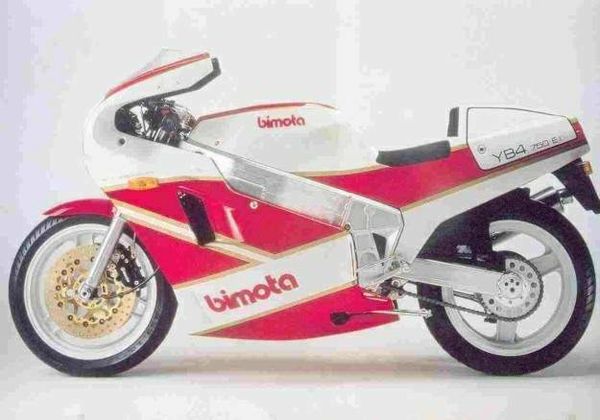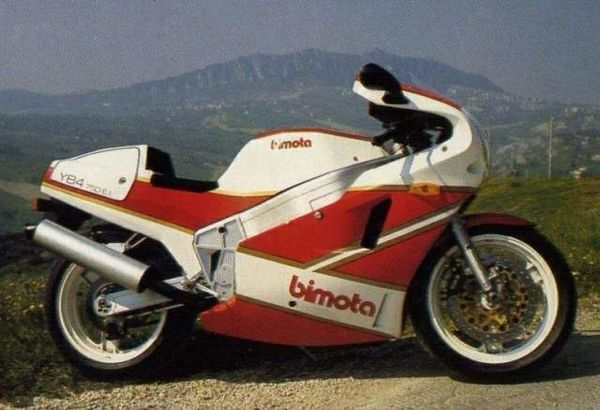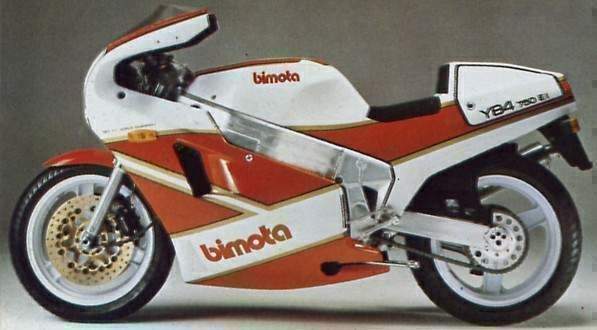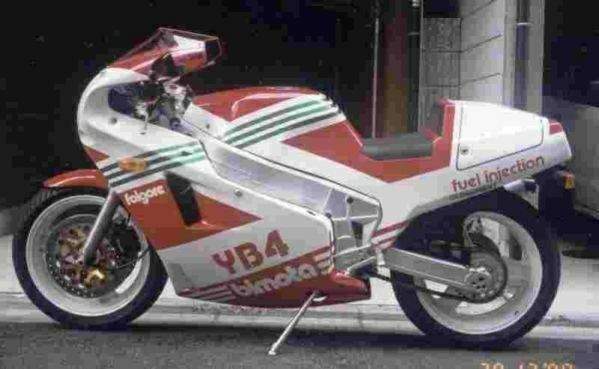Bimota YB4750IE
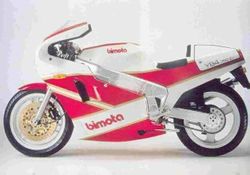 |
|
| Bimota YB4750IE | |
| Manufacturer | |
|---|---|
| Production | 303 units |
| Engine | Four stroke, transverse four cylinder, DOHC, 5 valves per cylinder. |
| Compression ratio | 11.2:1 |
| Ignition | CDI |
| Transmission | 6 Speed |
| Frame | Two diagonal beams in section bar made of aluminum with internal ribbing. The cylinders are supported by plates bolted to the beams and the swing arm is made of aluminum |
| Suspension | Front: 42mm Gas telescopic forks, external adjustment for anti-dive Rear: Gas single shock, external adjustment |
| Brakes | Front: 2x 320mm discs Rear: Single 230mm disc |
| Front Tire | 3.50-17 |
| Rear Tire | 5.50-17 |
| Weight | 180 kg / 396.8 lbs. (dry), |
| Fuel Capacity | 20 Liters / 5.3 gal |
| Manuals | Service Manual |
Engine[edit | edit source]
The engine was a Liquid cooled cooled Four stroke, transverse four cylinder, DOHC, 5 valves per cylinder.. The engine featured a 11.2:1 compression ratio.
Chassis[edit | edit source]
It came with a 3.50-17 front tire and a 5.50-17 rear tire. Stopping was achieved via 2x 320mm discs in the front and a Single 230mm disc in the rear. The front suspension was a 42mm Gas telescopic forks, external adjustment for anti-dive while the rear was equipped with a Gas single shock, external adjustment. The YB4750IE was fitted with a 20 Liters / 5.3 gal fuel tank. The bike weighed just 180 kg / 396.8 lbs..
Photos[edit | edit source]
Overview[edit | edit source]
Bimota YB4 EI
In race trim, this motorcycle won the 1987 Formula-One World Championship and ended five years of Honda domination in the most important four-stroke racing class. It was a victory that marked the arrival of Bimota on the world stage. The tiny Italian factory had taken on the mighty Japanese works teams and beaten them fair and square. Originally the YB4 was a pure racer unavailable for road use. With the advent of the World Superbike Championship in 1988 and its strict homologation rules, Bimota were obliged to build 200 YB4s in order to compete. Inevitably some ended up on the street. They also took the opportunity to make one important change - their Formula-One racer had been normally carburated, but the YB4 that finally went into series production was fuel-injected. The YB4 has always used a Yamaha FZ750 engine, the pioneering five valve, steeply inclined unit launched in 1985. The standard FZ engine never lacked top end power but was weak in midrange and low down output. It takes some winding up. Bimota's aim was to boost performance through fuel injection. The Weber Marelli electronic system in concert with the ignition advance liming meters the optimum amount of fuel and air through an injector into the intake manifold, to produce the ideal charge at a given rpm.
There are sensors to measure the throttle opening, phase of the
engine, coolant and air temperature, and air pressure is regulated at a
constant three bars. Ignition modules adjust the coil charge, and the whole
system is managed by a black box which has an interchangeable chip. In
theory, unburned gases are minimized and fuel consumption reduced. As the
engine is being fed the ideal mixture, power is increased across the rev
range. Although very fast in a straight line, it is not power that
gives the Bimota its main advantage, rather it is power-to-weight and a
beautifully crafted chassis keeps that weight low. The YB4's dry weight is a
keen 180kg.
The engine is used as a stressed member held in place by massive
aluminum beams with huge castings supporting the critical areas around the
steering head and rear swingarm pivot. Bimota pioneered aluminum perimeter
frame development at a time when all the other manufacturers were still
using steel double cradles and their original ideas on how to house heavy
Japanese engines have been shamelessly copied. Today, perimeter frames are
commonplace.
The YB4 has totally neutral handling - its behaviour is
predictable, smooth and supremely forgiving. The steering is sharp and
responsive, the suspension stiff and expertly damped. Its quick steering and
short wheelbase allow it to change direction very rapidly, yet its handling
is never nervous, it feels solid, low and compact, always letting the rider
know exactly what the tires are doing. Such was Bimota's success with
this bike during its heyday of 1987-1989, Yamaha were forced to release
their own World Superbike contender, the OWOl, featuring a comprehensively
revised FZR750 engine, larger bored, shorter stroking and making appreciably
more power than the five-year-old FZ750 design.
Because of the homologation
rules though, Bimota would have to build another 200 bikes in order to use
the new engine. Fuel injecting the older engine has helped increase the
power but really it is Bimota's wonderful rolling chassis that keeps the YB4
on the pace and in the hunt. It is a complete, perfectly balanced
motorcycle. Racers say that riding it almost becomes an extension of the
will, so direct is the feeling of contact with the track surface. All you
need is the will to win, and this gorgeous looking motorcycle does the rest.
| Make Model | Bimota YB4 EI |
|---|---|
| Year | 1988 |
| Production | 303 units |
| Engine Type | Four stroke, transverse four cylinder, DOHC, 5 valves per cylinder. |
| Displacement | 749 cc / 45.7 cub. in. |
| Bore X Stroke | 68 x 51.6 mm |
| Compression | 11.2:1 |
| Cooling System | Liquid cooled |
| Induction | Weber Marelli electronic fuel injection |
| Ignition | CDI |
| Starting | Electric |
| Max Power | 121 hp 89 KW @ 10500rpm |
| Max Power Rear Tire | 72.7 kW / 97.5 hp @ 10400 rpm |
| Max Torque | 88.3 Nm / 9.0kgf-m / 65.1 lb-ft.@ 8500rpm |
| Transmission | 6 Speed |
| Final Drive | Chain |
| Frame | Two diagonal beams in section bar made of aluminum with internal ribbing. The cylinders are supported by plates bolted to the beams and the swing arm is made of aluminum |
| Front Suspension | 42mm Gas telescopic forks, external adjustment for anti-dive |
| Rear Suspension | Gas single shock, external adjustment |
| Front Brakes | 2x 320mm discs |
| Rear Brakes | Single 230mm disc |
| Front Tire | 3.50-17 |
| Rear Tire | 5.50-17 |
| Dry Weight | 180 kg / 396.8 lbs. |
| Fuel Capacity | 20 Liters / 5.3 gal |
| Consumption Average | 6.5 l/100km / 36.2 mpg |
| Braking 60 - 0 / 100 - 0 | 13.2 m / 36.0 m 43.3 ft / 118.1 ft. |
| Standing ¼ Mile | 10.8 sec / 201.8 km/h / 125.4 mph |
| Road Test | Motosprint Group Test Moto.Journal Moto.Revue In.Moto YB4 vs RC30 BIKE Motorrad Motorrad YB4 vs FZR750R Motociclismo YB4 vs RC30 |
